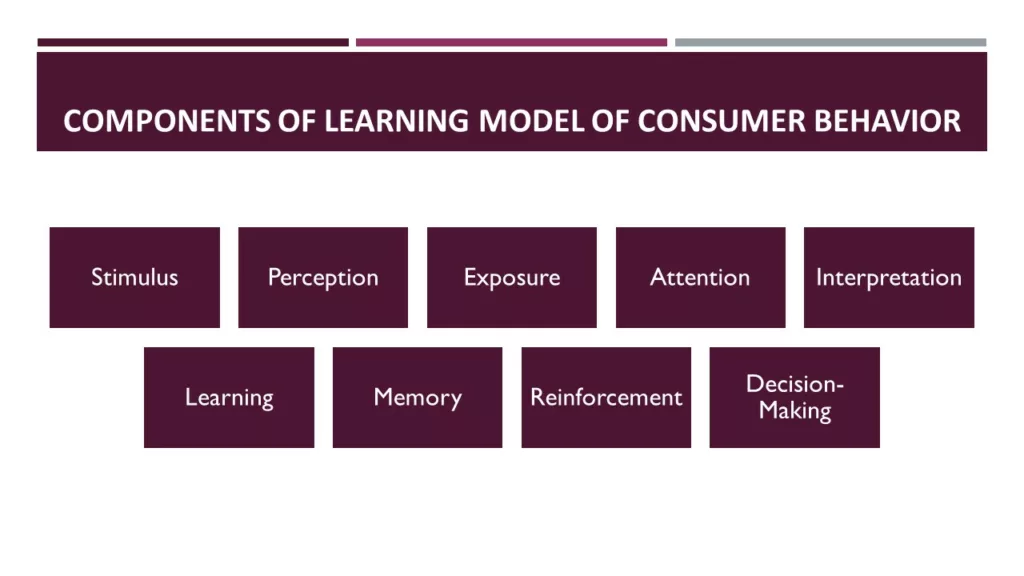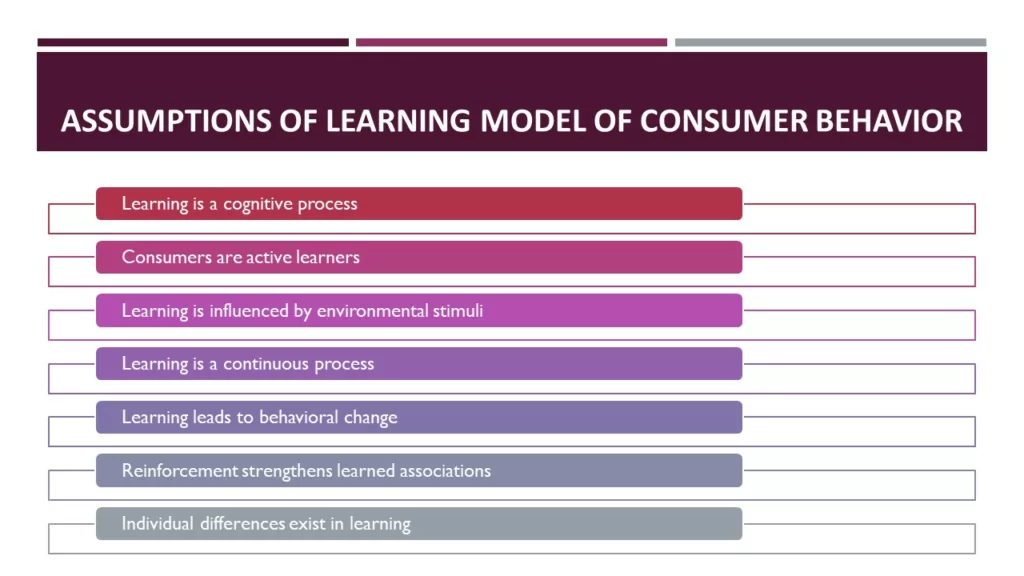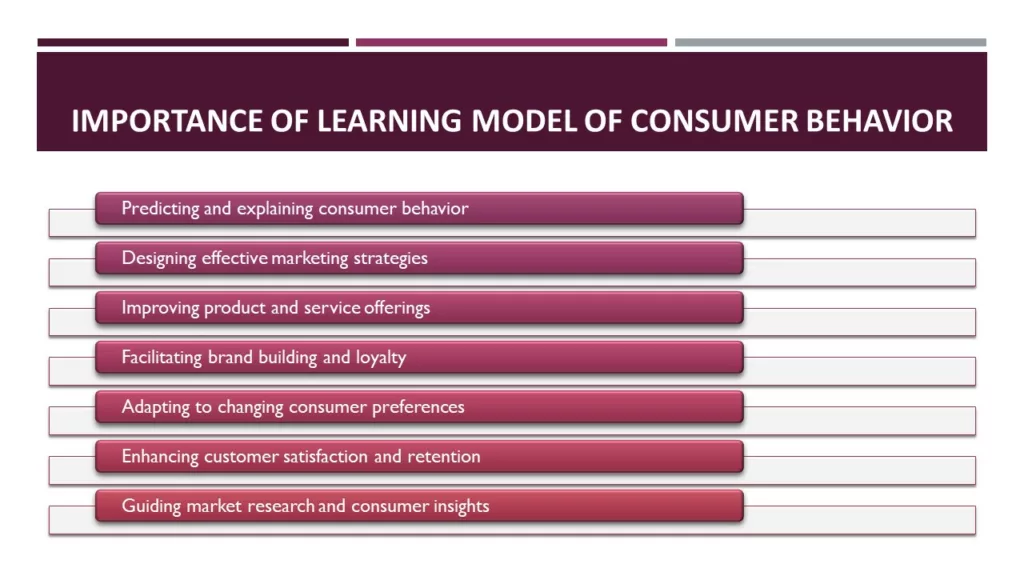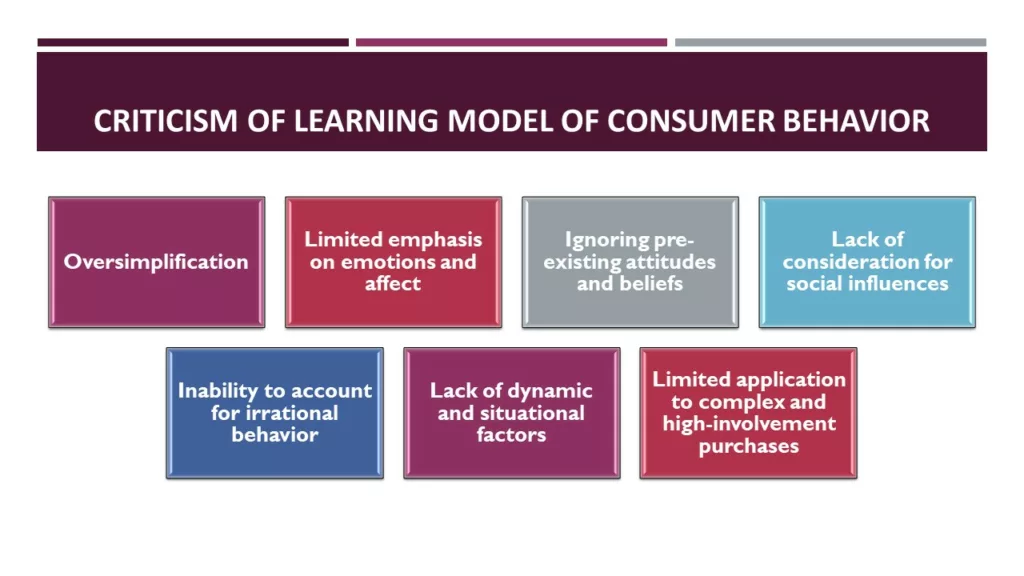The learning model of consumer behavior explores how individuals acquire, process, and respond to information and stimuli in the marketplace. It recognizes that consumer behavior is influenced by learning processes, including both cognitive and behavioral aspects. This model emphasizes the role of learning in shaping consumer preferences, attitudes, and decision-making, highlighting the importance of experiences, associations, and reinforcement in the formation of consumer behavior.
By understanding how consumers learn and adapt their behaviors, marketers can effectively tailor their strategies to influence consumer choices and foster brand loyalty. The learning model provides a framework for comprehending the dynamic nature of consumer behavior and offers insights into the strategies that can be employed to engage and connect with consumers effectively.

COMPONENTS OF LEARNING MODEL OF CONSUMER BEHAVIOR
The learning model of consumer behavior is a theoretical framework that explains how individuals acquire knowledge, attitudes, and behaviors related to making purchasing decisions. It consists of several key components that shape consumer learning. Here are the main components of the learning model of consumer behavior:

- Stimulus: Stimuli refer to the various marketing messages and cues that consumers are exposed to. These can include advertising, packaging, word-of-mouth recommendations, sales promotions, and other forms of marketing communication.
- Perception: Perception involves how consumers interpret and make sense of the stimuli they encounter. It includes the processes of attention, comprehension, and interpretation of marketing messages. Consumers’ perception of stimuli can be influenced by their personal characteristics, past experiences, and cultural background.
- Exposure: Exposure refers to the extent to which consumers are exposed to marketing stimuli. It depends on factors such as media consumption habits, social networks, and the availability of marketing channels. Increased exposure to stimuli increases the likelihood of consumer learning.
- Attention: Attention is the extent to which consumers focus their cognitive resources on the marketing stimuli. Consumers have limited attentional capacity, and they selectively pay attention to stimuli that are relevant, interesting, or novel to them. Marketers use various strategies to grab consumers’ attention, such as using catchy visuals or provocative messages.
- Interpretation: Interpretation involves the process of assigning meaning to the stimuli based on consumers’ existing knowledge and beliefs. Consumers may interpret marketing messages differently based on their individual perspectives, attitudes, and cultural background. Marketers need to consider how their messages may be interpreted by different segments of the target audience.
- Learning: Learning is a central component of the model, and it involves the acquisition of knowledge, attitudes, and behaviors through the exposure and interpretation of marketing stimuli. Learning can occur through different processes, including cognitive learning (acquiring information and knowledge), affective learning (developing attitudes and emotions), and behavioral learning (changing actual behaviors).
- Memory: Memory refers to the retention and retrieval of learned information over time. Consumers store information in their long-term memory and retrieve it when needed to make purchasing decisions. Memory plays a crucial role in consumer learning because it influences the recall and recognition of brands, product attributes, and past experiences.
- Reinforcement: Reinforcement is a key concept in the learning model, and it involves the consequences that follow consumer behaviors. Positive reinforcement, such as rewards or satisfaction, strengthens the association between a behavior and its outcome, increasing the likelihood of repeating the behavior. Negative reinforcement, such as dissatisfaction or punishment, decreases the likelihood of repeating a behavior.
- Decision-Making: The learning model ultimately affects consumers’ decision-making process. Consumer learning influences the evaluation of alternatives, the formation of preferences, and the final purchase decision. By understanding the learning processes, marketers can tailor their marketing strategies to influence consumer decision-making in a desired direction.
It’s important to note that the learning model of consumer behavior is a simplified representation of the complex psychological processes involved in consumer decision-making. Actual consumer behavior can be influenced by various additional factors, such as social influences, personal values, and situational factors.
ASSUMPTIONS OF LEARNING MODEL OF CONSUMER BEHAVIOR
The learning model of consumer behavior is based on several assumptions that provide a foundation for understanding how consumers acquire knowledge, attitudes, and behaviors. Here are some common assumptions underlying the learning model of consumer behavior:

- Learning is a cognitive process: The model assumes that learning is a cognitive process that involves acquiring, processing, and storing information. It emphasizes the role of mental processes, such as attention, perception, interpretation, and memory, in shaping consumer behavior.
- Consumers are active learners: The model assumes that consumers actively engage in the learning process and seek out information that is relevant to their needs and goals. Consumers are not passive recipients of marketing stimuli but actively process and interpret them based on their individual characteristics and motivations.
- Learning is influenced by environmental stimuli: The model assumes that consumer learning is influenced by the marketing stimuli to which individuals are exposed. These stimuli can include advertising messages, product features, packaging, pricing, and other forms of marketing communication. The model recognizes that the environment plays a significant role in shaping consumer learning.
- Learning is a continuous process: The model assumes that learning is an ongoing and continuous process rather than a one-time event. Consumers continually acquire new information, update their knowledge, and revise their attitudes and behaviors based on new experiences and exposure to marketing stimuli. Learning is a dynamic process that can occur throughout the consumer’s lifetime.
- Learning leads to behavioral change: The model assumes that consumer learning ultimately leads to behavioral change. As consumers acquire new knowledge and attitudes, they are more likely to engage in behaviors that align with their newly acquired beliefs and preferences. Learning can lead to changes in purchase decisions, brand choices, and consumption patterns.
- Reinforcement strengthens learned associations: The model assumes that reinforcement plays a significant role in consumer learning. Positive reinforcement, such as rewards or satisfaction, strengthens the association between a behavior and its outcome, making it more likely to be repeated. Negative reinforcement, such as dissatisfaction or punishment, weakens the association and reduces the likelihood of repeating a behavior.
- Individual differences exist in learning: The model recognizes that individual consumers differ in their learning capabilities, cognitive processes, and prior experiences. Different individuals may interpret and respond to marketing stimuli in unique ways based on their personality traits, values, cultural background, and cognitive abilities. The model acknowledges the importance of individual differences in understanding consumer learning.
It’s important to note that while these assumptions provide a theoretical framework for understanding consumer behavior, individual consumers may not always conform to these assumptions in practice. Real-world consumer behavior is complex and influenced by a variety of factors, including social influences, situational factors, and personal values.
IMPORTANCE OF LEARNING MODEL OF CONSUMER BEHAVIOR
The learning model of consumer behavior is important for several reasons. It provides a framework for understanding how consumers acquire knowledge, form attitudes, and make purchasing decisions. Here are some key reasons why the learning model of consumer behavior is important:

- Predicting and explaining consumer behavior: The learning model helps marketers and researchers predict and explain consumer behavior. By understanding how consumers acquire and process information, marketers can develop more effective strategies to influence consumer decision-making. The model helps explain why consumers develop certain preferences, why they choose one brand over another, and how their behaviors change over time.
- Designing effective marketing strategies: The learning model informs the design of marketing strategies and tactics. By understanding how consumers learn and respond to marketing stimuli, marketers can tailor their messages, advertisements, and promotional activities to effectively reach and influence their target audience. The model helps marketers identify the most effective ways to grab consumers’ attention, communicate product benefits, and create positive associations with their brands.
- Improving product and service offerings: The learning model helps organizations improve their product and service offerings. By understanding how consumers acquire knowledge about products and services, companies can identify areas where consumers may have informational gaps or misconceptions. This knowledge can guide the development of clearer product information, educational materials, and customer support to enhance consumers’ understanding and satisfaction.
- Facilitating brand building and loyalty: The learning model helps organizations build strong brands and foster customer loyalty. By understanding how consumers learn and form associations, marketers can create consistent brand messages and experiences that align with consumers’ needs and desires. Through effective brand positioning and reinforcement, organizations can develop long-term relationships with consumers and create a loyal customer base.
- Adapting to changing consumer preferences: The learning model helps organizations adapt to changing consumer preferences and market trends. By monitoring consumer learning processes, organizations can identify shifts in attitudes, beliefs, and behaviors. This understanding allows them to respond proactively by adjusting their marketing strategies, launching new products or services, or modifying existing offerings to meet evolving consumer needs.
- Enhancing customer satisfaction and retention: The learning model helps organizations understand how consumers evaluate and perceive their products and services. By considering consumers’ learning processes, companies can identify factors that contribute to customer satisfaction or dissatisfaction. This knowledge can inform efforts to improve product quality, customer service, and post-purchase support, thereby enhancing customer satisfaction and increasing customer retention.
- Guiding market research and consumer insights: The learning model provides a foundation for conducting market research and gaining consumer insights. By understanding how consumers learn and form attitudes, researchers can design studies to explore specific aspects of consumer behavior, preferences, and decision-making. The model guides the formulation of research questions, study designs, and data analysis methods, resulting in valuable insights for marketers and organizations.
Overall, the learning model of consumer behavior is essential for understanding how consumers learn, process information, and make decisions. It guides the development of effective marketing strategies, helps build strong brands, and enhances customer satisfaction and retention. By applying the principles of the learning model, organizations can better meet consumer needs, stay competitive in the market, and drive business success.
REAL LIFE APPLICATIONS OF LEARNING MODEL OF CONSUMER BEHAVIOR
The learning model of consumer behavior has various real-life applications across different industries. Here are some examples of how the learning model is applied in practice:

- Advertising and Marketing Campaigns: Marketers use the learning model to design and execute advertising and marketing campaigns. They study consumer learning processes to create effective advertisements that capture attention, communicate key messages, and influence consumer behavior. By understanding how consumers acquire knowledge and form associations, marketers can develop campaigns that resonate with their target audience and lead to desired outcomes.
- Product and Packaging Design: The learning model is employed in product and packaging design to enhance consumer understanding and appeal. Companies consider consumers’ learning processes to develop user-friendly product designs, clear labeling, and packaging that effectively communicates product benefits. By aligning with consumers’ cognitive processes, companies can facilitate faster and easier learning about their products, resulting in increased purchase likelihood.
- Brand Positioning and Differentiation: The learning model helps organizations position their brands and differentiate themselves from competitors. By understanding how consumers form brand associations and preferences, companies can strategically communicate unique brand attributes and benefits that align with consumers’ needs. This knowledge enables businesses to create a distinct brand image and build brand loyalty through consistent reinforcement of desired associations.
- Customer Education and Support: Organizations apply the learning model to educate and support customers in understanding their products or services. By considering consumers’ learning processes, companies can develop informative content, tutorials, FAQs, and customer support systems that address common queries and facilitate learning. Improved customer education enhances satisfaction, reduces confusion, and builds customer loyalty.
- New Product Development: The learning model informs the development of new products and services. Companies conduct consumer research to understand consumers’ needs, preferences, and learning processes related to a specific product category. This knowledge helps in designing innovative products that align with consumer expectations and are easy to understand and adopt, accelerating the learning process and acceptance of the new offerings.
- Customer Relationship Management (CRM): The learning model is applied in CRM strategies to enhance customer satisfaction and retention. By understanding how consumers learn and evolve their preferences, companies can personalize their interactions, offer targeted recommendations, and provide tailored experiences based on customers’ past behaviors and preferences. This personalized approach strengthens customer relationships and fosters loyalty.
- E-commerce and Online Retail: The learning model is relevant in the context of e-commerce and online retail. Online retailers leverage consumer learning processes to optimize website layouts, product descriptions, and user interfaces. By aligning with consumers’ cognitive processes, companies can enhance the online shopping experience, facilitate learning about product features, and improve conversion rates.
- Customer Reviews and Social Proof: The learning model is applicable to customer reviews and social proof strategies. Consumers often rely on the experiences and opinions of others to learn about products and make purchasing decisions. Companies leverage this by encouraging and promoting positive customer reviews and testimonials, which serve as social proof and influence the learning and decision-making processes of potential customers.
These are just a few examples of how the learning model of consumer behavior is applied in real-life scenarios. The model’s principles are widely used to inform marketing strategies, product development, customer interactions, and other areas to better understand and influence consumer behavior.
CRITICISM OF LEARNING MODEL OF CONSUMER BEHAVIOR
While the learning model of consumer behavior provides valuable insights into the processes by which consumers acquire knowledge and make purchasing decisions, it is not without its criticisms. Here are some common criticisms of the learning model:

- Oversimplification: One criticism of the learning model is that it oversimplifies the complex nature of consumer behavior. Real-world consumer behavior is influenced by a wide range of factors, including social, cultural, and psychological influences, which are not adequately captured by the model. The model’s focus on cognitive processes and individual learning overlooks the social and cultural dimensions that shape consumer behavior.
- Limited emphasis on emotions and affect: The learning model tends to place less emphasis on the role of emotions and affective factors in consumer behavior. Emotional responses and subjective experiences play a significant role in shaping consumer decision-making, but these aspects are not fully addressed in the cognitive-focused learning model.
- Ignoring pre-existing attitudes and beliefs: The learning model assumes that consumers approach purchasing decisions as blank slates, ready to be influenced solely by marketing stimuli. However, consumers often enter the decision-making process with pre-existing attitudes, beliefs, and prior experiences that can strongly influence their responses to marketing stimuli. The model’s limited consideration of these pre-existing factors is a notable criticism.
- Lack of consideration for social influences: The learning model does not adequately address the influence of social factors on consumer behavior. Consumers are not isolated individuals, but rather embedded in social networks and influenced by social norms, cultural values, and interpersonal interactions. The model’s focus on individual cognitive processes neglects the powerful impact of social influences on consumer decision-making.
- Inability to account for irrational behavior: The learning model assumes that consumers are rational decision-makers who carefully evaluate information and make optimal choices. However, consumers often exhibit irrational behavior, such as impulse buying, irrational preferences, and decision biases. The model’s emphasis on rational learning processes may not fully capture these irrational aspects of consumer behavior.
- Lack of dynamic and situational factors: The learning model tends to treat consumer behavior as a static and individualistic process, overlooking the dynamic and situational nature of consumer decision-making. Consumer behavior can vary across different situations, contexts, and timeframes. The model’s focus on individual learning processes may not adequately account for these dynamic and situational influences.
- Limited application to complex and high-involvement purchases: The learning model is often seen as more applicable to low-involvement, routine purchases rather than complex and high-involvement decisions. For complex purchases, consumers may engage in extensive information search, consider multiple alternatives, and rely on various decision-making heuristics beyond the scope of the learning model.